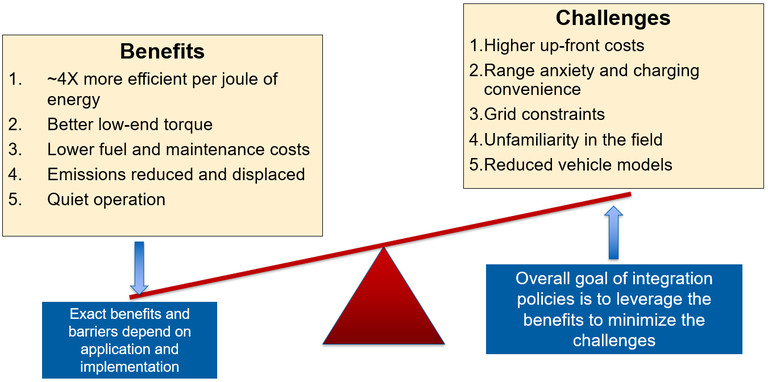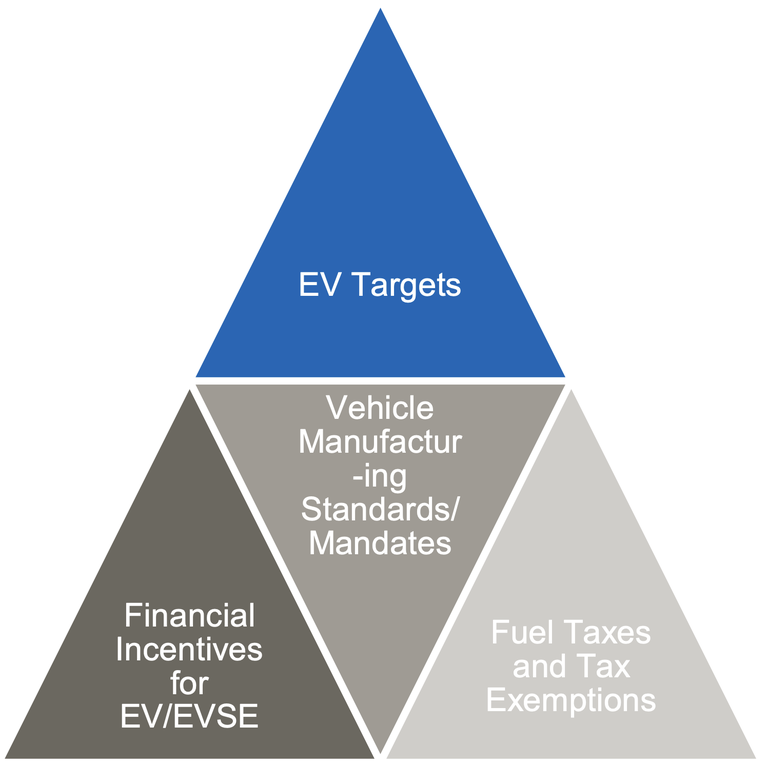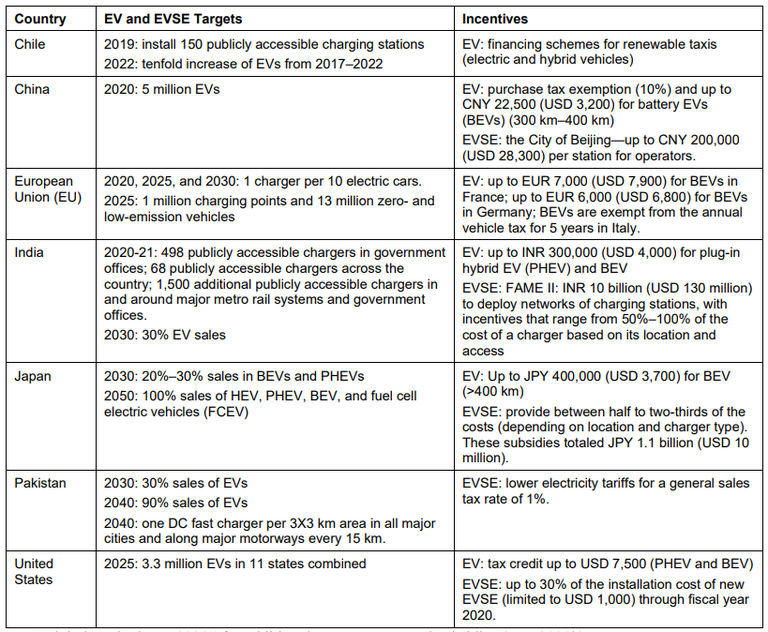Policies to Incentivize EV Adoption and Deployment
Overview
The success of electric vehicle (EV) market development hinges on a range of policy measures that target both EV adoption and the deployment of charging infrastructure. Effective policy approaches are shaped by the goals and objectives set by governments, such as climate targets and economic benefits, which in turn influence the selection and prioritization of specific policies, targets, and incentives. These policy approaches are aimed at mitigating the challenges of EV adoption by leveraging the benefits of the technology (as shown in Figure 1). Furthermore, EV policy approaches should consider equity concerns to ensure that the benefits and costs of EV deployment are distributed broadly and fairly.
Figure 1. The Overall Goal of Integration Policies is to Leverage the Benefits to Minimize the Challenges (Caley Johnson, NREL).

Policymakers at various levels of government—local, regional, and federal—can implement a variety of policies to promote EV adoption and infrastructure development integrated with other city-wide sustainable transport planning considerations. These measures include financial incentives, such as purchase rebates and tax credits, and non-financial incentives, such as preferential parking and access to restricted traffic zones. Establishing clear policy direction and delegation of authority is crucial for the effective implementation of these policies.
While individual policies can drive progress, their effectiveness is amplified when supported by broader EV market development frameworks. Comprehensive policy frameworks include setting EV and EV charging infrastructure targets, using purchase incentives to reduce upfront costs, and establishing vehicle manufacturing standards and mandates. A holistic approach ensures that policies are implemented efficiently and equitably to ensure that the benefits of EVs are widespread throughout a society.
An illustrative example of successful policy support is seen in Indonesia, where targeted incentives have significantly boosted electric car sales. Prior to 2019, annual sales of electric cars in Indonesia were below 100 units, but by 2023, this number surged to 17,000. This growth was driven by substantial purchase incentives, including a reduced Value-Added Tax, exemptions from luxury and import taxes, and regional tax reductions. The increased model availability, particularly from foreign manufacturers such as Chinese companies, has further fueled this growth. Indonesia remains committed to its ambitious EV targets, including having 2 million electric cars and 13 million electric two/three-wheelers by 2030. This case highlights how targeted policies can drive market expansion and attract international investment, contributing to overall EV market development.
Figure 2. Categories of EV and EV Supply Equipment (EVSE) Policy Approaches (Building Blocks of Electric Vehicle Deployment: A Guide for Developing Countries).

Table 1. Summary of EV and EVSE Targets and Subsidies in Select Countries (Building Blocks of Electric Vehicle Deployment: A Guide for Developing Countries).

Key Actions for EV Market Development
Policymakers at different levels of government can create policies tailored to their specific country contexts to incentivize EV deployment and achieve EV targets. They can set EV and EV charging infrastructure deployment targets to offer a long-term vision for market development and send important investment signals to industry. By establishing clear goals, governments can guide the design of specific policy instruments that support market growth.
- Determine Clear EV and EV Charging Infrastructure Targets: Setting clear and achievable EV and EV charging infrastructure targets can provide a long-term vision for market development. These targets can help guide the creation of specific policy instruments that encourage investment and infrastructure development to ensure a cohesive strategy for market growth.
- Implement Financial and Non-Financial Incentives: Governments can use various policy instruments to increase EV adoption and infrastructure deployment. Purchase incentives can reduce the upfront costs of EVs, making them more attractive to consumers. Emissions requirements can encourage automakers to sell more zero-emissions vehicles. Soft-cost incentives, such as free parking or reduced registration fees, can also lower the total cost of ownership. Standards and mandates can ensure the supply of EVs by requiring manufacturers to produce more fuel-efficient and low-emission vehicles.
- Foster Utility Engagement and Support: Utilities can collaborate with partners at multiple levels to encourage EV adoption and manage EV integration effectively. They can promote EV adoption through financial incentives like public access to charging infrastructure, user-friendly electricity tariffs, and rate discounts. Additionally, utilities can enhance grid stability by adopting tariffs that shift EV charging to off-peak times and managed charging technologies.
- Address Equity Concerns in EV Deployment: Policy approaches can address equity concerns related to EV deployment by expanding access to EVs and EV charging infrastructure and fairly allocating the costs of EV incentives to avoid disproportionately burdening low-income or marginalized groups. Furthermore, deployment activities can increase access to EVs that don’t require vehicle purchases, such as buses or rideshare. Electrifying vehicles that serve disadvantaged communities, like delivery trucks and buses, helps ensure that the health benefits of EVs are shared by everyone, especially in communities that are often most impacted by air pollution.
- Foster Home and Workplace Charging to Mitigate Range Anxiety: Home charging is highly effective, with over 80% of EV charging events among early adopters in the U.S. occurring at home, a trend observed at similar rates worldwide (DOE 2020). Implementing building codes that ensure homes and apartment complexes are "EV-Ready" or mandating the installation of chargers can support this trend. Many EVs come with a free home charger, further encouraging its use. Workplaces often use charging facilities as a recruitment tool to attract employees, taking advantage of long dwell times for EV charging. Additionally, managed charging at workplaces can benefit grid stability, especially when combined with solar energy during peak sunlight hours. Building codes in areas such as California now require Level 2 (L2) chargers at commercial buildings, contributing to broader workplace charging infrastructure.
- Incorporate Consumer Education and Awareness Programs: Comprehensive consumer education and awareness programs can build end-user demand for EVs. By informing the public about the benefits and incentives associated with EVs, these programs can help accelerate market adoption and ensure that consumers are well-informed about their choices.
- Reach A Consensus around National Standards: In order to mitigate risk around unstandardized equipment that can be dangerous and harmful to the grid and environment, national governments should consider establishing which standard(s) work best for their local context. This will also ensure that all vehicles within a country are compatible with all charging stations, which decreases costs and inefficiencies in the charging network.
The U.S. Agency for International Development (USAID) and National Renewable Energy Laboratory (NREL) Partnership supported Pakistan's National EV Policy, which targets electrifying 30% of passenger cars and heavy trucks and 50% of two- and three-wheelers by 2030. The Partnership has provided critical technical and policy guidance, sponsoring a 2024 training session in Islamabad on the Low Emissions Analysis Platform (LEAP) to equip Pakistani professionals with tools for integrated energy planning and climate mitigation. Additionally, virtual workshops held in 2022 addressed EV integration challenges. The Partnership also responded to the need for tailored support by exploring successful EV market penetration strategies from countries like Norway, China, and the United States. This review emphasized the effectiveness of financial incentives, exclusive access policies, and investments in charging infrastructure, aiming to strengthen Pakistan’s EV policy framework and create a favorable climate for clean energy technologies.
Read more about USAID-NREL Partnership projects here and explore how we are driving innovative solutions in clean energy and sustainable transport.
Resources
Global EV Outlook 2024 Policy Explorer
International Energy Agency (IEA), 2024
The Global EV Outlook Policy Explorer highlights current as well as announced key policies and measures that support the deployment of EVs and zero-emission vehicles (ZEVs) by region and country. These policies and measures take a variety of forms, e.g. fuel economy standards, CO2 emissions standards, deployment roadmaps, and sales or stock targets and ambitions
EV City Casebook and Policy Guide 2021 Edition
IEA, 2021
This technical report collects and highlights how cities around the world are building better and cleaner mobility infrastructure. By providing global EV innovation case studies, this report is designed to inspire a transition towards electric mobility. In addition to case studies, this report also includes policy guidance, and analyses of common challenges and lessons to accelerate the deployment of EVs.
Renewable Energy Policies for Cities: Transport
International Renewable Energy Agency (IRENA), 2021
This brief will highlight best practices in sustainable urban transport and showcase city actions that accelerate the creation of sustainable transport systems.
Effectiveness of Electric Vehicle Policies and Implications for Pakistan
USAID-NREL Partnership, 2020
This report examines the impact of various policies on EV market penetration, including financial incentives, road access, and infrastructure investments, by analyzing successful EV initiatives in countries such as Norway, China, and the U.S. It provides insights relevant to Pakistan and other global policymakers and highlights that financial incentives, exclusive access policies, and robust charging infrastructure are crucial for promoting EV adoption.
Electric Vehicle Supply Equipment: Tariff Design Support to the Lao PDR
USAID-NREL Partnership, 2020
This presentation, set in the context of Lao, delves into EV tariff design principles and considerations for both home and public charging. While it focuses on Lao, the information provided is applicable to general audiences and can be useful for understanding EV tariff structures and public EVSE retail charges more broadly.
Electric Vehicle Guidebook for Indian States
The International Council on Clean Transportation (ICCT), 2019
This guidebook helps state-level policymakers design effective EV policies by summarizing international best practices, offering a structured policy development cycle, and recommending 83 specific actions based on real-world case studies to overcome market barriers and support EV adoption.
If you are interested in collaborating or learning more about the USAID-NREL Partnership's international sustainable transport and electric mobility initiatives, please contact us to learn more about partnership opportunities.

